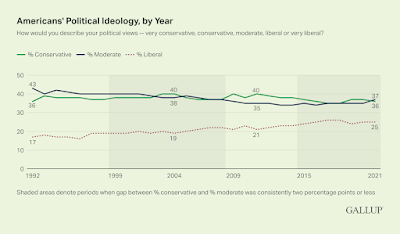The way Americans identify themselves ideologically was unchanged in 2021.... On average last year, 37% of Americans described their political views as moderate, 36% as conservative and 25% as liberal.Here are the numbers over the past thirty years (click to enlarge):
Unlike party ID, which varied considerably from one quarter to the next in 2021, Americans' description of their political views on the conservative-to-liberal spectrum showed no meaningful movement throughout the year.
It's true that moderates and conservatives are neck-and-neck, while liberals are a distant third, but that's been true for as long as Gallup has measured ideology this way. In fact, the percentage of Americans who call themselves liberals has risen eight points since the early '90s, while the percentage of moderates is down six points.
Our elections have been more or less 50-50 in all this time, which means that most moderate voters vote Democratic. This is tough if you're a liberal or progressive Democrat, because the party has to please moderates in order to win. (Though I've read enough stories about support for President Biden's agenda among swing-district left-centrist Democrats -- here's a recent example -- to believe that the problem isn't primarily moderates vs. liberals but, rather, corrupt crypto-Republicans Joe Manchin and Kyrsten Sinema vs. the rest of the party.
Gallup measures a significant increase in the number of Democrats who call themselves liberal (25% in 1994, 50% in 2021), but Republicans have also become an increasingly ideological party over that period. In 1994, 58% of Republicans called themselves conservative, and now the number is 74%. So the GOP was more ideologically homogeneous in the mid-'90s than the Democratic Party is today, and it's much more ideological now. And yet the Democratic Party is seen by many as the more extremist party, largely because Republican messaging is so much better than Democratic messaging.
If fewer people identified as Democrats as 2021 wore on, but that wasn't accompanied by a decline in the percentage of Americans who identify as liberal or moderate, then the Democratic slippage was a response to how the party functions, not what it stands for -- and it was also a response, as I said yesterday, to valorization of Republicans by Democrats as well as Republicans themselves.
America is not right-wing -- it's not even more right-wing than it was a year ago, or ten years ago. Democrats are still competitive in this environment, or they would be if saboteurs within their party would relent and allow them to pass a few bills.

No comments:
Post a Comment